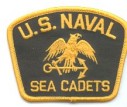US Naval Sea Cadets

The US Naval Sea Cadet Corps is a youth program for young Americans, male and female, ages 13 through 17 whose objectives are to develop an interest and skill in basic seamanship and in its naval adaptations, to train them in seagoing skills arid to teach them patriotism, courage. self-reliance and kindred virtues, as well as to learn about Navy SEALs and other naval organizations. Sea Cadets train aboard Navy and Coast Guard ships and shore activities. They are authorized by the Secretary of the Navy to wear Navy uniforms appropriately marked with Sea Cadet Corps insignia, however they are a non-profit organization and are not affiliated with the Department of Navy.
There are some 250 units in operation in almost every state in the union and Puerto Rico, with over 5,000 young Americans participating. The Naval Sea Cadet Corps affords equal opportunity for participation to all American youth without regard to race, color, religion or sex. The payback for this training occurs when Sea Cadets elect to join the nation's seagoing services. In 2001, 513 Sea Cadets elected to enter the armed forces, including 54 who enlisted in the Coast Guard, and seven who entered the Coast Guard Academy.
In 1958, the Department of the Navy and the Navy League, formally established the Naval Sea Cadet Corps (ages 14-17) and Navy League Cadet Corps (ages 11-13). The organization was later chartered by Congress as a civilian youth training program for young people ages 13 to 17. The Navy League later established the Navy League Cadet Corps (NLCC) for children ages 11 to 13. These programs help young Americans become more patriotic and responsible citizens. It also helps them understand the maritime services' role in national defense and our economy.
The majority of Sea Cadet training takes place locally at their "drill" site, usually a Navy or Coast Guard facility. During the summer, activities move from the local training site and involve two week hands-on training, a recruit training center, or aboard floating and shore units of the Navy and Coast Guard. Often, Sea Cadets fill in as part of the crew and perform tasks vital to the unit's mission completion.
Year round training program with local training conducted at a "drill" site, normally a reserve center or other military installation, school civic hall, or sponsor provided building. Local training includes classroom instruction, practical and hands-on training in firefighting, marksmanship, military drill, damage control, navigation, and anything else the military has to offer.
There are also visits to military facilities or other field trips, familiarization cruises on Navy or Coast Guard ships or small craft, community and civic activities, parades, and other activities. All of this is interspersed with instruction in drug and illegal substance abuse awareness training, sexual harassment sensitivity training, core values, and citizenship and cultural training.
Though the Armed services do not provide financial support to the NSCC, they support the NSCC through the use of the bases for cadet training and messing facilities. Also, the valuable asset of personnel comes from the military. They volunteer to instruct cadets in their area of expertise, and, as members of the NSCC Officer Corps, provide leadership for the local NSCC commands.
Most Sea Cadet units are sponsored by individual Councils of the Navy League of the United States. The Navy League is a nonprofit organization of U.S. citizens whose objectives are to support the U.S. sea services and assist young Americans. Sea Cadets are instructed by Navy and Coast Guard personnel (active. reserve and retired), and by, other adultleaders willing to devote their time and knowledge. Adult leadership comes from the NSCC Officer Corps , and from the Navy, Coast Guard, and Marine Corps.
Summer training is where all the really in depth training comes in to play: For first year Sea Cadets (14-18 yrs): A two-week recruit training , or "Boot Camp", at RTC Great Lakes, or other regional training sites. For first year Navy League Cadets (11-14 yrs): A one-week Orientation. Advanced Sea Cadet training includes duty on board Navy and Coast Guard ships, Leadership Academy, SEAL indoctrination, Medical training, SeaBees (construction training), Special Boat training, Music school, Submarine Indoctrination, Basic and Advanced Airman's school, Security, and a myriad of other opportunities.
Senior, experienced, and mature Cadets are chosen to staff the recruit training, and Leadership Academies. Advanced Navy League Cadet training consists of a one-week Advanced Orientation For the Sea Cadets there is also the International Exchange program. This involves an exchange of 100 U.S. Naval Sea Cadets training with their counterparts from countries such as Canada, United Kingdom, Belgium, The Bahamas, and many others.
Sea Cadets that do join the military have an edge. They know what it's really like out there. They know what they want to do, and usually know what they have to do to get it. Sea Cadets that decide to become military Officers, have a higher success rate than the average applicant, because they have developed the leadership and integrity that the military wants. Sea Cadets that complete all the requirements for the rank of NSCC E-3, are allowed to enlist in the Navy or Coast Guard at an advanced paygrade (E-3).
There are also several college scholarships for cadets and former cadets who meet published criteria. Sea Cadets wear the Navy's uniform, have a promotion ladder similar to the Navy's, and earn our own ribbons. There is a modest annual membership fee, and Cadets are charged for their meals while serving on military installations/vessels. There are a limited number of training grants available so that everyone can benefit from the training programs. There are also a few college scholarships available to assist Cadets in furthering their education after High School.
|
NEWSLETTER
|
| Join the GlobalSecurity.org mailing list |
|
|
|

